Laser Hybrid Butt Welding of Large Thickness Naval Steel
Abstract
:1. Introduction
1.1. Classification Societies and Standards
1.2. Welding in Shipbuilding
1.3. LAHW in Shipbuilding
2. Materials and Methods
2.1. Materials for Steel Naval Construction
2.1.1. Base Metal
2.1.2. Filler Wire
2.2. Welding Processes Parameters
2.2.1. Laser parameters
2.2.2. Arc Parameters
2.3. Joint Design and Edge Preparation
3. Results
3.1. Joint Characterization
3.2. Macrostructure
3.3. Joint Imperfections
3.4. Microstructure
3.5. Mechanical Properties
3.5.1. Tensile Strength
3.5.2. Hardness
3.5.3. Impact Toughness
3.6. Fatigue
4. Conclusions
Author Contributions
Funding
Conflicts of Interest
References
- Zhang, S.; Shen, Y.; Qiu, H. The technology and welding joint properties of hybrid laser-TIG welding on thick plate. Opt. Laser Technol. 2013, 48, 381–388. [Google Scholar] [CrossRef]
- Atabaki, M.M.; Nikodinovski, M.; Chenier, P.; Ma, J.; Liu, W.; Kovacevic, R. Experimental and numerical investigations of hybrid laser arc welding of aluminum alloys in the thick T-joint configuration. Opt. Laser Technol. 2014, 59, 68–92. [Google Scholar] [CrossRef]
- Cui, L.; Chen, B.; Qian, W.; He, D.; Chen, L. Microstructures and Mechanical Properties of Dissimilar Al/Steel Butt Joints Produced by Autogenous Laser Keyhole Welding. Metals 2017, 7, 492. [Google Scholar] [CrossRef]
- Steen, W.M.; Mazumder, J. Laser Material Processing, 4th ed.; Springer: London, UK; Dordrecht, The Netherlands; Berlin/Heidelberg, Germany; New York, NY, USA, 2010; Volume 4, pp. 216–218. [Google Scholar] [CrossRef]
- Unt, A.; Poutiainen, I.; Grünenwald, S.; Sokolov, M.; Salminen, A. High Power Fiber Laser Welding of Single Sided T-Joint on Shipbuilding Steel with Different Processing Setups. Appl. Sci. 2017, 7, 1276. [Google Scholar] [CrossRef]
- Guen, E.L.; Fabbro, R.; Carin, M.; Coste, F.; Masson, P.L. Analysis of hybrid Nd:Yag laser-MAG arc welding processes. Opt. Laser Technol. 2011, 43, 1155–1166. [Google Scholar] [CrossRef] [Green Version]
- Ishide, S.; Watanabe, M. Latest MIG, TIG, arc-YAG laser hybrid welding systems for various welding products. In Proceedings of the International Symposium on High-Power Laser Macroprocessing, Osaka, Japan, 27–31 May 2002; pp. 347–352. [Google Scholar]
- Ascari, A.; Fortunato, A.; Orazi, L.; Campana, G. The influence of process parameters on porosity formation in Hybrid LASER-GMA welding of AA6082 aluminium ally. Opt. Laser Technol. 2012, 44, 1485–1490. [Google Scholar] [CrossRef]
- Steen, W.M.; Eboo, M.; Clarke, J. Arc augmented laser welding. In Proceedings of the 4th International Conference on Advantages in Welding Processes, Harrogate, UK, 9–11 May 1978; Volume 1, pp. 257–265. [Google Scholar]
- Górka, J.; Stano, S. Microstructure and Properties of Hybrid Laser Arc Welded Joints (Laser Beam-MAG) in Thermo-Mechanical Control Processed S700MC Steel. Metals 2018, 8, 132. [Google Scholar] [CrossRef]
- Ready, J.F. Industrial Applications of Lasers, 2nd ed.; Academic Press: London, UK, 1997. [Google Scholar]
- Seyffarth, P.; Krivtusun, I.V. Laser-arc Processes and Their Applications in Welding and Material Treatment; Taylor & Francis: London, UK, 2002. [Google Scholar]
- Turichin, G.; Kuznetsov, M.; Klimova-Korsmik, O.; Sklyar, M.; Zhitenev, A.; Kurakin, A.; Pozdnyakov, A. Laser-Arc hybrid welding perspective ultra-high strength steels: Influence of the chemical composition of weld metal on microstructure and mechanical properties. Procedia CIRP 2018, 74, 752–756. [Google Scholar] [CrossRef]
- Shi, J.; Zhou, Y.; Liu, L. Application of Pulsed Laser-TIG Hybrid Heat Source in Root Welding of Thick Plate Titanium Alloys. Appl. Sci. 2017, 7, 527. [Google Scholar] [Green Version]
- Li, C.; Muneharua, K.; Takao, S.; Kouji, H. Fiber laser-GMA hybrid welding of commercially pure titanium. Mater. Des. 2009, 30, 109–114. [Google Scholar] [CrossRef]
- Casalino, G.; Campanelli, S.L.; Dal Maso, U.; Ludovico, A.D. Arc leading versus laser leading in the hybrid welding of aluminium alloy using a fiber laser. Procedia CIRP 2013, 12, 151–156. [Google Scholar] [CrossRef]
- Huang, L.; Wu, D.; Hua, X.; Liu, S.; Jiang, Z.; Li, F.; Wang, H.; Shi, S. Effect of the welding direction on the microstructural characterization in fiber laser-GMAW hybrid welding of 5083 aluminum alloy. J. Manuf. Process. 2018, 31, 514–522. [Google Scholar] [CrossRef]
- Casalino, G.; Leo, P.; Mortello, M.; Perulli, P.; Varone, A. Effects of Laser Offset and Hybrid Welding on Microstructure and IMC in Fe–Al Dissimilar Welding. Metals 2017, 7, 282. [Google Scholar] [CrossRef]
- Gao, M.; Chen, C.; Gu, Y.; Zeng, X. Microstructure and Tensile Behavior of Laser Arc Hybrid Welded Dissimilar Al and Ti Alloys. Materials 2014, 7, 1590–1602. [Google Scholar] [CrossRef] [PubMed] [Green Version]
- Dilthey, U.; Lüder, F.; Wieschemann, A. Expanded capabilities in the welding of aluminium alloys with the laser-MIG hybrid process. Aluminium 1999, 75, 64–75. [Google Scholar]
- Dilthey, U.; Wieschemann, A. Prospects by combining and coupling laser beams and arc welding processes. Riv. Ital. Saldatura 1999, 52, 749–759. [Google Scholar]
- Graf, T.; Staufer, H. Laser Hybrid Process at Volkswagen; IIW-Doc. XII-1730-02; International Institute of Welding: Copenhagen, Denmark, 2002. [Google Scholar]
- Dilthey, U.; Lüder, F.; Wieschemann, A. Technical and economical advantages by synergies in laser arc hybrid welding. Weld. World 1999, 943, 141–152. [Google Scholar]
- Petring, D.; Fuhrmann, C. Recent progress and innovative solutions for laser-arc hybrid welding. In Proceedings of the 1st Pacific International Conference on Application of Lasers and Optics, Merbourne, Australia, 19–21 April 2004; pp. 7–10. [Google Scholar]
- Fronius International GmbH. Available online: https://www.fronius.com/cps/rde/xchg/SID-F92B902E-920234D8/fronius_international/hs.xsl/79_687_ENG_HTML.htm#.WLQh5dR97Gg (accessed on 28 October 2018).
- ESAB. Hybrid Laser Welding. Available online: https://www.esab.com/automation/en/process/Hybrid-Laser-Welding.cfm (accessed on 28 October 2018).
- Carl Cloos Schweisstechnik GmbH. Available online: https://www.cloos.de/de-en/ (accessed on 28 October 2018).
- Cloos. Available online: https://www.cloos.de/de-en/products/qineo/laser-hybrid-weld/ (accessed on 28 October 2018).
- Lincoln Electric. Hybrid Laser Arc Welding. Available online: https://www.lincolnelectric.com/assets/US/EN/literature/mc1129.pdf (accessed on 28 October 2018).
- Fronius. LASERHYBRID. Available online: http://www.fronius.com/es-es/spain/tecnologia-de-soldadura/productos/soldadura-robotizada/alto-desempe%C3%B1o-migmag/laserhybrid/laserhybrid (accessed on 28 October 2018).
- PEMA Welding Automation. Pema Welding and Production Automation for Shipbuilding. Available online: https://pemamek.com/welding-solutions/ship-building/ (accessed on 28 October 2018).
- Lancaster, J. Handbook of Structural Welding, 1st ed.; Abington Publishing: Abington, UK, 1997. [Google Scholar]
- Annals of Lloyd’s Register, Centenary Edition ed; Lloyd’s Register of Shipping: London, UK, 1934.
- Lane, P.H.R. Lloyd’s Register-surveying for quality. Met. Mater. 1985, 1, 484–488. [Google Scholar]
- Lloyd’s Register. Rules and Regulations for the Classification of Ships Part 3, Ship Structures; Chapter 10; Lloyd’s Register: London, UK, 1999. [Google Scholar]
- Veritas, D.N. Rules for the Classification of Ships/High Speed, Light Craft and Naval Surface Craft; New Building, Materials and Welding, Part 2, Chapter 3; DNV GL A.S.: Oslo, Norway, 2016. [Google Scholar]
- American Bureau of Shipping. Rules for Building and Classing Steel Vessels; Part 2, Section 3; American Bureau of Shipping: Houston, TX, USA, 1997. [Google Scholar]
- International Association of Classification Societies. Common Structural Rules for Bulk Carriers; International Association of Classification Societies: London, UK, 2008. [Google Scholar]
- ISO International Organization for Standardization. Available online: https://www.iso.org/standards.html (accessed on 28 October 2018).
- López, E.; Spiegelberg, J.M.; Carrillo, F. Inglés Técnico Naval, 2nd ed.; Universidad de Cádiz: Cádiz, Spain, 1994. [Google Scholar]
- Petershagen, H. Trends in design and fabrication of ship structures. In Advanced Joining Technologies; North, T.H., Ed.; Chapman and Hall: London, UK, 1990. [Google Scholar]
- Figure of a Portal Frame. Available online: https://www.kranendonk.com/sites/default/files/styles/full_width_images/public/2015-double-hull-welding.jpg?itok=UAAteQLd (accessed on 28 October 2018).
- Kolarik, L.; Kolarikova, M.; Kovanda, K.; Pantucek, M.; Vondrou, S.P. Evaluation of Modern Power Source for GMAW Welding Equipped with Advanced arc Control; Faculty of Mechanical Engineering: Prague, Czech Republic, 2012; pp. 322–326. [Google Scholar]
- Apps, B.; Crossland, B.; Fenn, R.; Evans, C. Killer Consequences of Defective Welds—A Plan for Prevention; TWI Bulletin: Candbridge, UK, 2002. [Google Scholar]
- Tsubota, S.; Ishide, T.; Watanabe, M.; Akaba, T. Laser Welding System for Various 3-D Welding-Development of Coaxial Laser Welding Head; Mitsubishi Heavy Industries Ltd.: Tokyo, Japan, 2005; Volume 42, No. 2; Available online: https://www.mhi.co.jp/technology/review/pdf/e422/e422086.pdf (accessed on 2 November 2018).
- Laser Welding Heads. Available online: http://www.lasertrader.co.uk/index.php/products/precitec-roducts/laser-welding-heads/yh50-hybrid-welding-head (accessed on 28 October 2018).
- Turichin, G.; Kuznetsov, M.; Tsibulskiy, I.; Firsova, A. Hybrid Laser-Arc Welding of the High-Strength Shipbuilding Steels: Equipment and Technology. Nordic Laser Materials Processing Conference, NOLAMP_16, 22–24 August 2017, Aalborg University, Denmark. Phys. Procedia 2017, 89, 156–163. [Google Scholar] [CrossRef]
- Agrawal, B.P.; Kumar, R. Challenges in application of pulse current gas metal arc welding process for preparation of weld joint with superior quality. Int. J. Eng. Res. Technol. 2016, 5, 319–327. [Google Scholar] [CrossRef]
- Webster, S.E. Hyblas: Economical and Safe Laser Hybrid Welding of Structural Steel: Final Report; Research Fund for Coal and Steel, Contract RFSR-CT-2003-00010; Corus UK Limited: South Yorkshire, UK, 2009. [Google Scholar]
- Zhang, C.; Li, G.; Gao, M.; Zeng, X.Y. Microstructure and mechanical properties of narrow gap laser-Arc hybrid welded 40 mm thick mild steel. Materials 2017, 10, 106. [Google Scholar] [CrossRef] [PubMed]
- Guidelines for the Approval of CO2 Laser Welding; Lloyd’s Register: London, UK, 1997.
- EU BRITE-EURAM Project BE 97-4223: SHILWACQ ’Shipbuilding Laser Welding: An Integrated System for Assurance and Quality Control.
- Rules for the Manufacture, Testing and Certification of Materials; Rolled Steel Plates, Strip, Sections and Bars, Chapter 3, Section 2; Lloyd’s Register: London, UK, 2016; pp. 45–47.
- Mizuno, M.; Nagaoka, H. Application of Al-Mg alloys to large welded structures in Japan. Int. Met. Rev. 1979, 24, 68–81. [Google Scholar] [CrossRef]
- Holsberg, P.W.; Gudas, J.P.; Caplan, I.L. Welding of high strength low alloy steels. Weld. Met. 1990, 58, 492–495. [Google Scholar]
- Rethmeier, M.; Sergej, G.; Marco, L.; Andrey, G. Laser-Hybrid Welding of Thick Plates up to 32 mm Using a 20 kW Fibre Laser. Q. J. Jpn. Weld. Soc. 2009, 27, 74–79. [Google Scholar] [CrossRef] [Green Version]
- Turichin, G.I.; Tsibulskiy, M.; Kuznetsov, A.; Akhmetov, M.; Mildebrath, T. Influence of the Gap Width on the Geometry of the Welded Joint in Hybrid Laser-Arc Welding. Phys. Procedia 2015, 78, 14–23. [Google Scholar] [CrossRef] [Green Version]
- Üstündağ, Ö.; Fritzsche, A.; Avilov, V.; Gumenyuk, A.; Rethmeier, M. Hybrid laser-arc welding of thick-walled ferromagnetic steels with electromagnetic weld pool support. Weld. World 2018, 62, 767–774. [Google Scholar] [CrossRef]
- Wetzel, G.; Neubert, J.; Kranz, B. Investigations of properties in hybrid welds at 40-mm sheet thickness. Weld. World 2014, 58, 883–891. [Google Scholar] [CrossRef]
- Bunaziv, I.; Frostevarg, J.; Akselsen, O.M.; Kaplan, A.F.H. The penetration efficiency of thick plate laser-arc hybrid. Int. J. Adv. Manuf. Technol. 2018, 97, 2907–2919. [Google Scholar] [CrossRef]
- Bunaziv, I.; Frostevarg, J.; Akselsen, O.M.; Kaplan, A.F.H. Laser-arc hybrid welding of thick HSLA steel. J. Mater. Process. Technol. 2018, 259, 75–87. [Google Scholar] [CrossRef]
- Wahba, M.; Mizutani, M.; Katayama, S. Single pass hybrid laser-arc welding of 25 mm thick square groove butt joints. Mater. Des. 2016, 97, 1–6. [Google Scholar] [CrossRef]
- Kah, P.; Salminen, A.; Martikainen, J. The influence of parameters on penetration, speed and bridging in laser hybrid welding. Mechanika 2011, 17, 324–333. [Google Scholar] [CrossRef]
- Kah, P.; Salminen, A.; Martikainen, J. The effect of the relative location of laser beam with arc in different hybrid welding processes. Int. Congr. Appl. Lasers Electro-Opt. 2018, 2009, 1604. [Google Scholar] [CrossRef]
- Bunaziv, I.; Akselsen, O.M.; Salminen, A.; Unt, A. Fiber laser-MIG hybrid welding of 5 mm 5083 aluminum alloy. J. Mater. Process. Technol. 2016, 233, 107–114. [Google Scholar] [CrossRef]
- Kah, P.; Martikainen, J. Current trends in welding processes and materials: Improve in effectiveness. Rev. Adv. Mater. Sci. 2012, 30, 189–200. [Google Scholar]
- Mundada, S.S.; Matani, A.G. Process Improvement through Hybrid Laser-Mig Welding in Medium Scale Farm Equipment Industry. Int. J. Latest Trends Eng. Technol. 2016, 6, 145–149. [Google Scholar]
- Church; G. Joining Giants. Laser Systems Europe. Hybrid Welding. Issue: Summer 2016. Available online: https://www.lasersystemseurope.com/feature/joining-giants (accessed on 2 November 2018).
- Verhaeghe, G. Low-Porosity Laser Welding of 12.7 mm Thickness Aerospace Aluminium; INALCO: Tokyo, Japan, 2007. [Google Scholar]
- Gerritsen, C.; Howarth, D. A Review of the development and application of laser and laser-arc hybrid welding in European shipbuilding. In Proceedings of the 11th CF/DRDC International Meeting on Naval Applications of Materials Technology, Halifax, NS, Canada, 7–9 June 2005. [Google Scholar]
- Akselsen, O.M.; Wiklund, G.; Østby, E.; Sǿrgjerd, A.; Kaplan, A.F.H. A first Assessment of Laser Hybrid Welding of 420 MPa Steel for Offshore Structure Application. In Proceedings of the 14th NOLAMP Conference: The 14th Nordic Laser Materials Processing Conference, Gothenburg, Sweden, 26–28 August 2013. [Google Scholar]
- Kristensen, J.K. Thick Plate CO2-Laser based Hybrid Welding of Structural Steels. Weld. World 2009, 53, 48–57. [Google Scholar] [CrossRef]
- Bunaziv, I.; Frostevarg, J.; Akselsen, O.M.; Kaplan, A.F.H. Hybrid Welding of 45 mm High Strength Steel Sections. Phys. Procedia 2017, 89, 11–22. [Google Scholar] [CrossRef]
- Bachmann, M.; Gumenyuk, A.; Rethmeier, M. Welding with high-power lasers: Trends and developments. Phys. Procedia 2016, 83, 15–25. [Google Scholar] [CrossRef]
- Cai, C.; Li, L.; Tai, L. Narrow-gap laser-MIG hybrid welding of thick-section steel with different shielding gas nozzles. Int. J. Adv. Manuf. Technol. 2017, 92, 909–916. [Google Scholar] [CrossRef]
- Nielsen, S.E. High Power Laser Hybrid Welding—Challenges and Perspectives. Phys. Procedia 2015, 78, 24–34. [Google Scholar] [CrossRef]
- Bunaziv, I.; Frostevarg, J.; Akselsen, O.M.; Kaplan, A.F.H. Process stability during fiber laser-arc hybrid welding of thick steel plates. Opt. Lasers Eng. 2018, 102, 34–44. [Google Scholar] [CrossRef]
- Kah, P. Overview of the exploration status of laser-arc hybrid welding processes. Rev. Adv. Mater. Sci. 2012, 30, 112–132. [Google Scholar]
- Farrokhi, F.; Kristiansen, M.A. Practical Approach for Increasing Penetration in Hybrid Laser-arc Welding of Steel. Phys. Procedia 2016, 83, 577–586. [Google Scholar] [CrossRef]
- Farrokhi, F.; Mikael, R. Single-pass hybrid laser welding of 25 mm thick steel. Phys. Procedia 2017, 89, 49–57. [Google Scholar] [CrossRef]
- Wahba, M.; Mizutani, M.; Katayama, S. Hybrid laser-arc welding with backing and cut-wire. In Proceedings of the 9th International Conference on Photonic Technologies (LANE), Fürth, Germany, 19–22 September 2016. [Google Scholar]
- Chen, Y.; Feng, J.; Li, L.; Chang, S.; Ma, G. Microstructure and mechanical properties of a thick-section high-strength steel welded joint by novel double-sided hybrid fibre laser-arc welding. Mater. Sci. Eng. A 2013, 582, 284–293. [Google Scholar] [CrossRef]
- Reisgen, U.; Olschok, S.; Jakobs, S. Laser Submerged Arc Welding (LUPuS) with Solid State Lasers. Phys. Procedia 2014, 56, 653–662. [Google Scholar] [CrossRef] [Green Version]
- International Organization for Standardization (ISO). EN ISO 13919-1. Welding—Electron and Laser-Beam Welded Joints—Guidance on Quality Levels for Imperfections; ISO: Geneva, Switzerland, 1996. [Google Scholar]
- International Organization for Standardization (ISO). EN ISO 12932. Welding—Laser-arc Hybrid Welding of Steels, Nickel and Nickel Alloys—Quality Levels for Imperfections; ISO: Geneva, Switzerland, 2013. [Google Scholar]
- Qinglong, P.; Mizutani, M.; Kawahito, Y.; Katayama, S. Effect of shielding gas on laser–MAG arc hybrid welding results of thick high-tensile-strength steel plates. Weld. World 2016, 60, 653–664. [Google Scholar] [CrossRef]
- Acherjee, B. Hybrid laser arc welding: State-of-art review. Opt. Laser Technol. 2018, 99, 60–71. [Google Scholar] [CrossRef]
- Casalino, G.; Dal Maso, U.; Angelastro, A.; Campanelli, S.L. Hybrid Laser Welding: A Review; DAAAM International Scientific Book: Vienna, Austria, 2010; pp. 413–430. [Google Scholar]
- Olsen, F.O. Hybrid Laser-arc Welding, 1st ed.; Woodhead Publishing Limited: Oxford, UK, 2009. [Google Scholar]




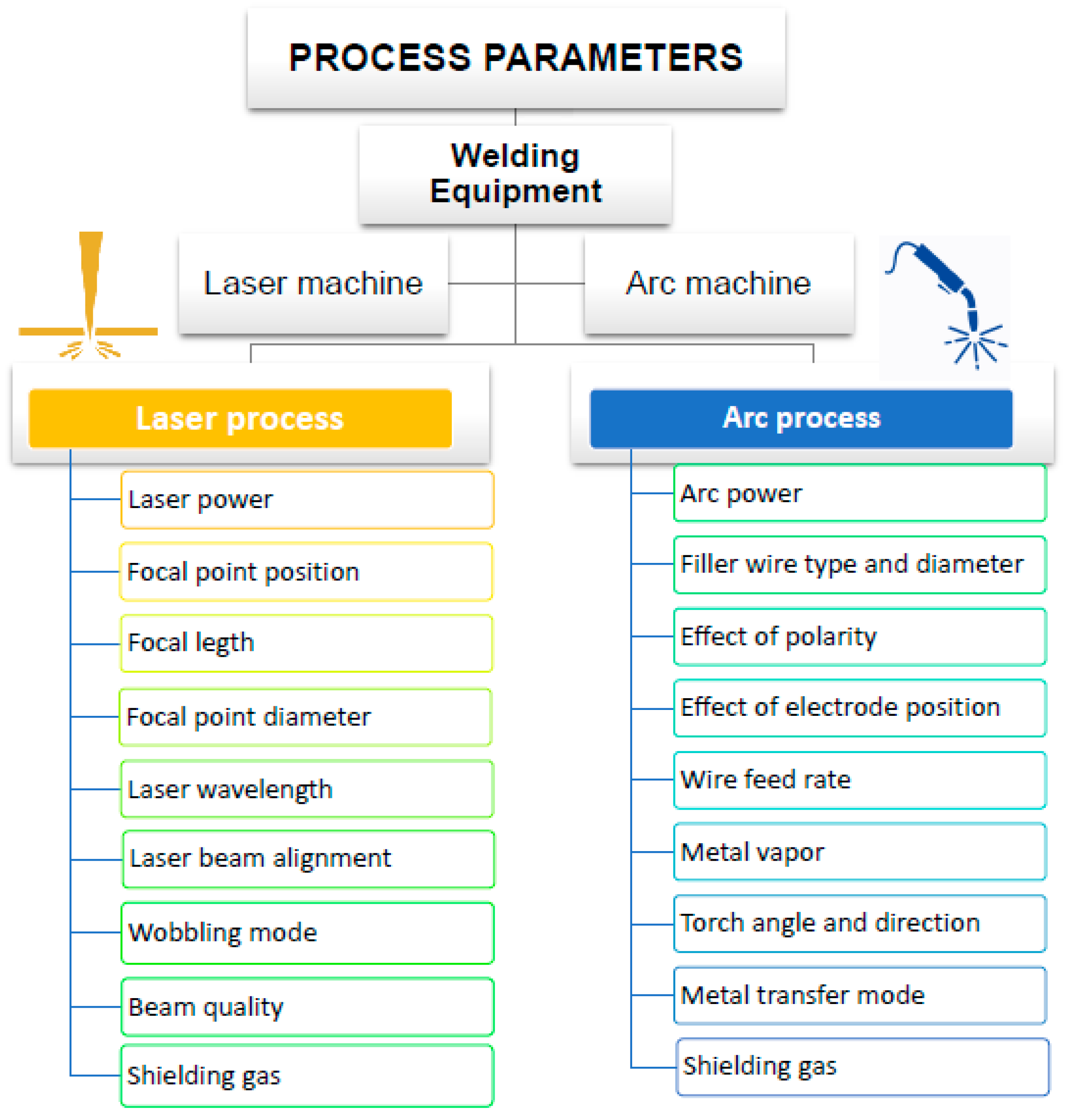



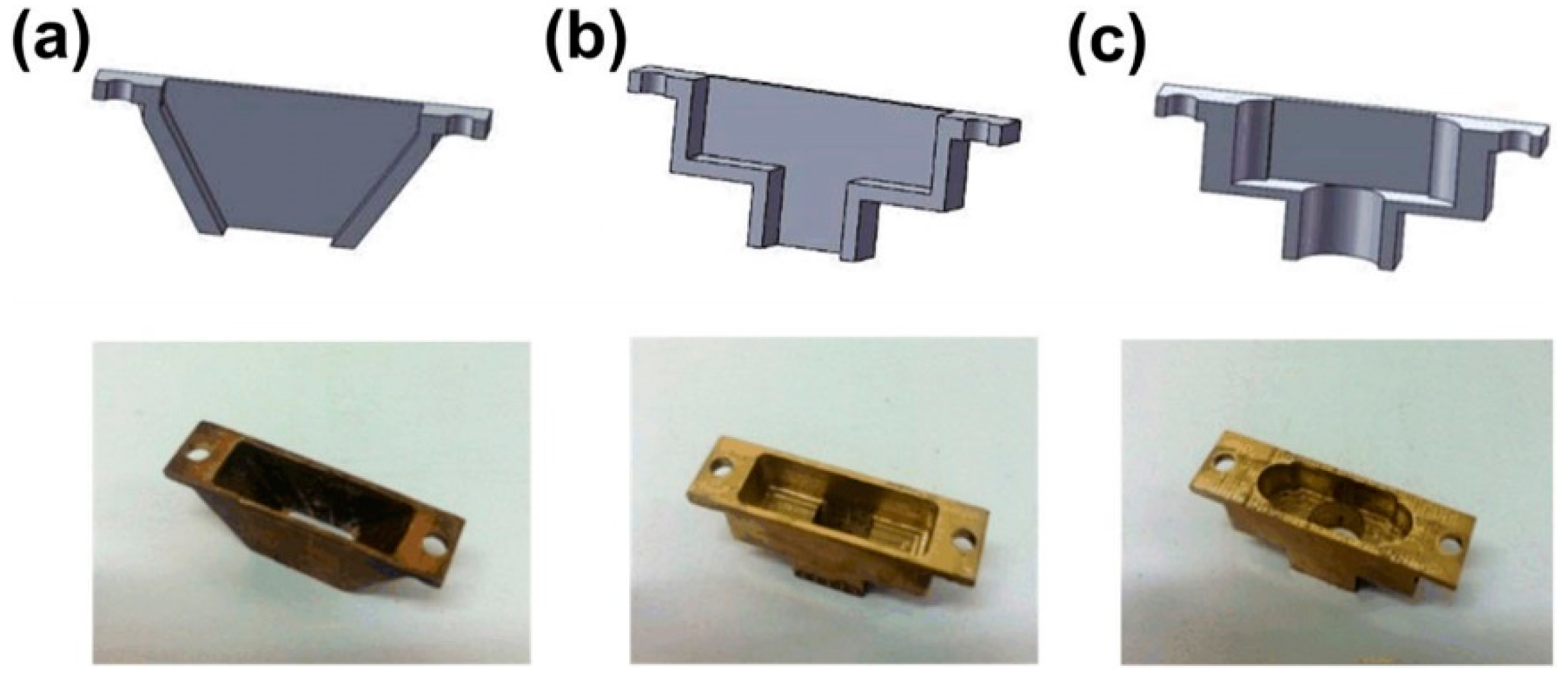









| Identification | Description |
|---|---|
| ISO 12932:2013 | Welding. Laser-Arc Hybrid Welding of Steels, Nickel and Nickel Alloys. Quality Levels for Imperfections. |
| ISO 15614-14:2013 | Specification and Qualification of Welding Procedures for Metallic Materials. Welding Procedure Test. Part 14: Laser-Arc Hybrid Welding of Steels, Nickel and Nickel Alloys. |
| ISO 15609-6:2013 | Specification and Qualification of Welding Procedures for Metallic Materials. Welding Procedure Specification. Part 6: Laser-Arc Hybrid Welding. |
| ISO 15613:2004 | Specification and Qualification of Welding Procedures for Metallic Materials - Qualification Based on Pre-Production Welding Test. |
| Grade | Chemical Composition (wt.%) | ||||||||
|---|---|---|---|---|---|---|---|---|---|
| C | Mn | Si | P | S | Al | Nb | V | Ti | |
| max | min | max | max | max | min | max | |||
| A | 0.21 | 2.5 × C | 0.5 | 0.04 | 0.04 | - | - | - | - |
| AH32 | 0.18 | 0.9–1.6 | 0.5 | 0.035 | 0.03 | 0.015 | 0.02–0.05 | 0.03–0.10 | 0.02 |
| AH36 | |||||||||
| AH40 | |||||||||
| B | 0.21 | 0.80 | 0.35 | 0.04 | 0.04 | - | - | - | - |
| D | 0.21 | 0.60 | 0.1–0.35 | 0.04 | 0.04 | 0.015 | - | - | - |
| DH32 | 0.18 | 0.9–1.6 | 0.5 | 0.035 | 0.03 | 0.015 | 0.02–0.05 | 0.03–0.10 | 0.02 |
| DH36 | |||||||||
| DH40 | |||||||||
| E | 0.18 | 0.70 | 0.1–0.35 | 0.04 | 0.04 | 0.015 | - | - | - |
| EH32 | 0.18 | 0.9–1.6 | 0.5 | 0.035 | 0.03 | 0.015 | 0.02–0.05 | 0.03–0.10 | 0.02 |
| EH36 | |||||||||
| EH40 | |||||||||
| FH32 | 0.16 | 0.9–1.6 | 0.5 | 0.025 | 0.025 | 0.015 | 0.02–0.05 | 0.03–0.10 | 0.02 |
| FH36 | |||||||||
| FH40 | |||||||||
| Mechanical Properties | |||||
|---|---|---|---|---|---|
| Grade | Yield Strength, YS (min) | Ultimate Tensile Strength, UTS | Elongation, ΔL (min) | Charpy V (min) | |
| MPa | MPa | % | °C | J | |
| A | 235 | 400–490 | 22 | - | - |
| AH32 | 315 | 440–590 | 22 | 0 | 31 |
| AH36 | 355 | 490–620 | 21 | 0 | 34 |
| AH40 | 390 | 510–650 | 20 | 0 | 41 |
| B | 235 | 400–490 | 22 | - | 27 |
| D | 235 | 400–490 | 22 | −20 | 27 |
| DH32 | 315 | 440–590 | 22 | −20 | 31 |
| DH36 | 355 | 490–620 | 21 | −20 | 34 |
| DH40 | 390 | 510–650 | 20 | −20 | 41 |
| E | 235 | 400–490 | 22 | −40 | 27 |
| EH32 | 315 | 440–590 | 22 | −40 | 31 |
| EH36 | 355 | 490–620 | 21 | −40 | 34 |
| EH40 | 390 | 510–650 | 20 | −40 | 41 |
| FH32 | 315 | 440–590 | 22 | −60 | 31 |
| FH36 | 355 | 490–620 | 21 | −60 | 34 |
| FH40 | 390 | 510–650 | 20 | −60 | 41 |
| Grade | Nominal Chemical Composition (wt.%) | Yield Strength (min) | |||||||||
|---|---|---|---|---|---|---|---|---|---|---|---|
| C | Mn | Si | Cr | Mo | Ni | Nb | V | Cu | ksi | MPa | |
| HY80 | 0.15 | 0.25 | 0.25 | 1.4 | 0.4 | 2.7 | - | 0.01 | - | 80 | 550 |
| HSLA 80 | 0.04 | 0.55 | 0.30 | 0.7 | 0.2 | 0.9 | 0.04 | - | 1.2 | 80 | 550 |
| HY 100 | 0.15 | 0.25 | 0.25 | 1.4 | 0.4 | 2.9 | - | 0.01 | - | 100 | 690 |
| HSLA 100 | 0.04 | 0.90 | 0.25 | 0.6 | 0.6 | 3.5 | 0.03 | - | 1.6 | 100 | 690 |
| Chemical Composition (wt.%) | ||||||||||
|---|---|---|---|---|---|---|---|---|---|---|
| Steel | C | Si | Mn | P | S | Cr | Ni | Cu | Mo | Fe |
| API 5L X65 | 0.08 | 0.28 | 1.67 | 0.012 | 0.001 | 0.01 | 0.01 | 0.19 | 0.01 | Bal |
| Chemical Composition (wt% Maximum) | ||||||||||||||||
|---|---|---|---|---|---|---|---|---|---|---|---|---|---|---|---|---|
| Base Metal | Filler Wire | Ø (mm) | Ref. | C | Si | Mn | P | S | Cr | Ni | Cu | V | Nb | Mo | Ti+Zr | Fe |
| RS E36 | Pb 60M | 1.6 | [57] | 0.04 | 0.40 | 1.30 | - | - | - | 0.40 | - | - | - | - | - | Bal. |
| 0.08 | 0.80 | 1.60 | 0.015 | 0.015 | - | 0.60 | - | - | - | - | - | |||||
| S355J2 API 5L X65 | G3 Nil | 1.2 1.6 | [56] [57] [58] | 0.06 0.14 | 0.50 0.90 | 1.00 1.60 | 0.02 | 0.02 | 0.15 | 0.80 1.50 | 0.35 | 0.03 | - | 0.15 | 0.15 | Bal. |
| S235 S355 API 5L X65 | G3 Sil | 1.2 | [56] [49] [59] | 0.05 | 0.86 | 1.38 | 0.009 | 0.011 | 0.02 | 0.02 | 0.09 | 0.004 | <0.001 | <0.005 | - | Bal. |
| HSLA Steel plates | Trustarc MX-A55T | 1.2 | [60] [61] | 0.06 | 0.35 | 1.41 | 0.011 | 0.017 | - | 1.48 | - | - | - | - | - | Bal. |
| SM490A With cut-wire | MG-50 YM-26 ER70SG | 1.0 | [62] | 0.04 | 0.71 | 1.6 | 0.022 | 0.007 | - | - | 0.24 | - | - | - | 0.19 | Bal. |
| Q235 Mild steel | ER70S-6 | 1 | [50] | 0.08 | 0.92 | 1.52 | 0.020 | 0.015 | Others ≤ 0.5 | Bal. | ||||||
| Filler Wire | Ultimate Tensile Strength, UTS | Yield Strength, YS | Elongation, ΔL | Impact Energy at −40 °C |
|---|---|---|---|---|
| MPa | MPa | % | J | |
| Pb 60M | 590–700 | >470 | ≥21 | ≥50 |
| ER70S-6 | ≥550 | ≥420 | ≥30 | ≥150 |
| G3 Ni1 | ≥570 | ≥450 | ≥26 | ≥45 |
| Laser Parameters | Common Parameters | |||||||||
|---|---|---|---|---|---|---|---|---|---|---|
| Ref. | Base Material | Thickness | Types | Power | λ * | BPP ** | Focal Length | Speed Welding | Distance Arc-Laser | Gap |
| (mm) | (kW) | (µm) | (mm*mrad) | (mm) | (m/min) | (mm) | (mm) | |||
| [47] | RS E36 | 20, 45 | Yb Fibre | 16 | 1070 | 8 | - | - | - | - |
| [56] | API 5L X65 | 20, 32 | Yb Fibre | 20 | 1070 | 11.2 | 350 | 2 | - | 0.5 |
| [57] | RS E36 | 7 | Fibre | 15 | 1070 | 6.7 | 400 | 4.3 | - | 0.3 |
| [49] | S235, S355, RQT701 | 30 | CO2 | 17 | - | - | 300 | 0.8 | 2 | 0.5 |
| [60] [61] [73] | HSLA | 45 (two-passes & cut-wire) | Yb Fibre | 15 | 1070 | 10.3 | 300 | 0.8–1.2 | 3.5–4.5 | 0.3–3.0 |
| [72] | AH36 | 20 | CO2 | 17 | - | - | 300 | 0.5 | 2 | 0.5 |
| [71] | Offshore steel YS > 420 MPa | 20 | Fibre | 15 | - | - | 300 | 8.3 | - | 0–1.35 |
| GMAW Parameters | ||||||||||
|---|---|---|---|---|---|---|---|---|---|---|
| Ref. | Base Material | Thickness | Voltage | Intensity | Angle | Filler Wire | Wire Diameter | Feeding Rate | Gas Comp. | Flow Gas |
| (mm) | (V) | (A) | (degrees) | Comp. | (mm) | (m/min) | (%) | (l/min) | ||
| [47] | RS E36 | 20, 45 | 42 VAC 60 VDC | 420–550 | - | Pb 60 M | 1.2 | 10 | 80% Ar, 20% O2 | 25 |
| [56] | API 5L X65 | 20, 32 | 29.5–35.6 | 245–400 | 25 | G3Si1, G3Ni1 | 1.2 & 1.6 | - | - | - |
| [57] | RS E36 | 7 | 44 | 200–1500 | 30 | Pb 60M | 1.6 | 9.1 | 80% Ar, 20% O2 | 25 |
| [49] | S235, S355, RQT701 | 30 | 21–35.7 | - | - | G3Si1 | 1 | 6 | 10% Ar, 2% O2, He | 40 |
| [60] [61] [73] | HSLA | 45 (two-pass, cut-wire) | 20–36 | 250–440 | 20–30 | Trustarc MX-A55T | 1.2 | 8.3–12 | 82% Ar, 18% CO2 | 25 |
| [72] | AH36 | 20 | 27.1 | - | 20 | G3Si1 | 1 | 5 | 10% Ar, 2% O2, He | 40 |
| [71] | Offshore steel YS > 420 MPa | 20 (double-side) | 26 | 312 | 25 | 0.9% Ni, 0.09% C, 0.6% Si, 1.2% Mn | 1 | 3.3 | 92% Ar, 8% CO2 | 20 |
| Thickness (mm) | Steel | Hybrid Process | Process Configuration * | Groove Shape | Gap (mm) | Root Face Height (mm) | Angle | Ref. |
|---|---|---|---|---|---|---|---|---|
| 25 | AH36 | GMAW + CO2 | OS_MP | Y | 0.5 | 12 | 20° | [49,72] |
| S355J2 | GMAW + Disk | OS_MP | Y | 0 | 10 | 30° | [80] | |
| SM490A | GMAW + Fibre + cut wire | OS_MP | S | 2.5 | 0 | - | [62,81] | |
| S355J2 | GMAW + Disk | DS_SP OS_SP | S Y | 0 | - 6 to 8 | - | [79] [80] | |
| 28 | API 5L X65 | Fibre | OS_MP | Y | - | 16 | 45° | [56] |
| 30 | AH36 | GMAW + CO2 | OS_MP | Y | 0.5 | 12 | 20° | [49] |
| RQT701 | GMAW + CO2 | DS_SP | DY | 0.5 | 3 | 6°/10° | [49] | |
| High strength | GMAW + Fibre | DS_MP | K | 0.3–0.6 | 10 | 30° | [82] | |
| 32 | API 5L X65 | Fibre | OS_MP | U | 0 | 18 | 45° | [56] |
| 35 | API 5L X65 | SAW + Disk | DS_SP | DY | 0 | 25 | 70° | [83] |
| 60° | ||||||||
| 40 | Q235 | GMAW + Fibre | OS_MP | U | 6 | - | [50] | |
| P265GH | SAW + Disk | DS_SP | DY | 0 | 30 | 60° | [83] | |
| HSLA | GMAW + Fibre | DS_SP | DY | 0.6 | 5 | 4° | [73] | |
| S355 J2+N | GMAW | DS_MP | I | 0.5 | 5 20 | 14° 22° | [76] | |
| GMAW + SAW | DY | 0 | 20 | 45° | [59] | |||
| 50 | SM490A | GMAW + Fibre + cut wire | DS_SP | S | 2.5 | 0 | - | [62,81] |
| A | B | C | D | E | |
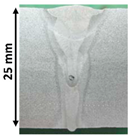 |  |  |  | 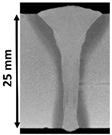 | |
| AH36 H1, T3 [49,72] | S355J2 H3, T3 [79] | S355J2 H3, T1 [80] | S355J2 H3, T2 [80] | SM490A H2+CW, T2 [62] | |
| F | G | H | I | J | |
 |  |  | 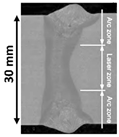 |  | |
| API 5L X65 H2, T2 [56] | RQT701 H1, T3 [49] | AH36 H1, T2 [49] | High-strength H2, T4 [82] | API 5L X65 H2, T2 [56] | |
| K | L | M | N | O | |
 | 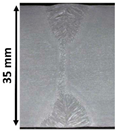 |  |  |  | |
| API X65 H5, T3 [83] | API X65 H4, T3 [83] | API X65 H4, T3 [83] | S355 J2+N H0, T3 [76] | HSLA H2+CW, T3 [60] | |
| P | Q | R | S | T | |
 | 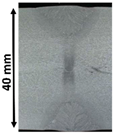 |  |  |  | |
| S355J2+N H6, T4 [59] | P265GH H4, T3 [83] | Q235 H2, T2 [50] | S355 J2+N H0, T4 [76] | SM490A H2+CW, T3 [62] | |
| U | |||||
 | All macros were adapted. H0—GMAW arc + laser H1—GMAW arc + CO2 laser H2—GMAW arc + Fibre laser H3—GMAW arc + Disk laser | H4—SAW arc + Disk laser H5—SAW arc + CO2 laser H6—GMAW + SAW CW—Cut Wire Technique | T1—OS_SP T2—OS_MP T3—DS_SP T4 - DS_MP | ||
| S460 H5, T3 [83] | |||||
© 2019 by the authors. Licensee MDPI, Basel, Switzerland. This article is an open access article distributed under the terms and conditions of the Creative Commons Attribution (CC BY) license (http://creativecommons.org/licenses/by/4.0/).
Share and Cite
Churiaque, C.; Chludzinski, M.; Porrua-Lara, M.; Dominguez-Abecia, A.; Abad-Fraga, F.; Sánchez-Amaya, J.M. Laser Hybrid Butt Welding of Large Thickness Naval Steel. Metals 2019, 9, 100. https://doi.org/10.3390/met9010100
Churiaque C, Chludzinski M, Porrua-Lara M, Dominguez-Abecia A, Abad-Fraga F, Sánchez-Amaya JM. Laser Hybrid Butt Welding of Large Thickness Naval Steel. Metals. 2019; 9(1):100. https://doi.org/10.3390/met9010100
Chicago/Turabian StyleChuriaque, Cristina, Mariane Chludzinski, Manuel Porrua-Lara, Antonio Dominguez-Abecia, Francisco Abad-Fraga, and Jose Maria Sánchez-Amaya. 2019. "Laser Hybrid Butt Welding of Large Thickness Naval Steel" Metals 9, no. 1: 100. https://doi.org/10.3390/met9010100





